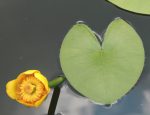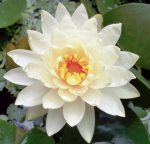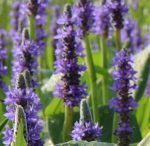 Common water hyacinth is a floating perennial native to the Amazon River Basin where it grows it wet habitats but was introduced into the US in 1884 at the World’s Fair in New Orleans by a group of Japanese people who gave out the plants as gifts, It is now considered invasive from North Carolina and Missouri, south to Florida and Texas, west to Arizona and California. Plants grow in fresh water and vary in size from a few inches to over 3′ tall. They have dark purplish to black feathery roots and are often joined to mother plants by floating stolons. The glossy, leathery leaves form a rosette and are rounded to broadly elliptic, 6″ wide, and carried on spongy 12″ long petioles. In summer, eight to fifteen showy flowers are appear above the leaves in a 12″ long spike. Each flower has 6 lavender-blue petals, the uppermost one with a yellow blotch. The fruit is a 3 celled capsule with many seeds. Common water hyacinth reproduces rapidly by seed and vegetative means and can become a major problem in lakes and rivers by replacing native vegetation and clogging waterways. USDA Hardiness Zones 9-11. Photo Credit: Wikipedia
Common water hyacinth is a floating perennial native to the Amazon River Basin where it grows it wet habitats but was introduced into the US in 1884 at the World’s Fair in New Orleans by a group of Japanese people who gave out the plants as gifts, It is now considered invasive from North Carolina and Missouri, south to Florida and Texas, west to Arizona and California. Plants grow in fresh water and vary in size from a few inches to over 3′ tall. They have dark purplish to black feathery roots and are often joined to mother plants by floating stolons. The glossy, leathery leaves form a rosette and are rounded to broadly elliptic, 6″ wide, and carried on spongy 12″ long petioles. In summer, eight to fifteen showy flowers are appear above the leaves in a 12″ long spike. Each flower has 6 lavender-blue petals, the uppermost one with a yellow blotch. The fruit is a 3 celled capsule with many seeds. Common water hyacinth reproduces rapidly by seed and vegetative means and can become a major problem in lakes and rivers by replacing native vegetation and clogging waterways. USDA Hardiness Zones 9-11. Photo Credit: Wikipedia
Yellow Pond Lily (Nuphar lutea)
 Also called brandy-bottle and spattercock, this aquatic deciduous perennial is native to Europe, Asia, northwest Africa, eastern US, and the West Indies where it grows in ponds, stream sides, and slow moving water. From a large rhizome growing in the sediment, the plants send up separate shoots bearing either large leaves that float on the water or flowering stems with cup shaped yellow flowers. The flat leathery leaves are up to 16″ long and are heart-shaped with wavy margins. Smaller leaves attached to the rhizome may appear below the water surface. The greenish yellow flowers are 2″ across and have a brandy like fragrance that is unpleasant to some. The flowers half open in the morning and close at night for about 4-5 days from May to October before giving way to brandy-bottle shaped seedpods that burst when ripe like those of the dock plant, giving rise to the common names brandy-bottle and spatterdock. Plants die back to the rhizome in the fall. USDA Hardiness Zones 4-10. Photo Credit: Wikimedia Commons
Also called brandy-bottle and spattercock, this aquatic deciduous perennial is native to Europe, Asia, northwest Africa, eastern US, and the West Indies where it grows in ponds, stream sides, and slow moving water. From a large rhizome growing in the sediment, the plants send up separate shoots bearing either large leaves that float on the water or flowering stems with cup shaped yellow flowers. The flat leathery leaves are up to 16″ long and are heart-shaped with wavy margins. Smaller leaves attached to the rhizome may appear below the water surface. The greenish yellow flowers are 2″ across and have a brandy like fragrance that is unpleasant to some. The flowers half open in the morning and close at night for about 4-5 days from May to October before giving way to brandy-bottle shaped seedpods that burst when ripe like those of the dock plant, giving rise to the common names brandy-bottle and spatterdock. Plants die back to the rhizome in the fall. USDA Hardiness Zones 4-10. Photo Credit: Wikimedia Commons
American White Water Lily (Nymphaea odorata)
 Also known as fragrant water lily and beaver root, this aquatic deciduous perennial is native to most of North American where it grows in up to 8′ of water in ponds, lakes, and slow moving water. From a root system of long forking rhizomes and fibrous roots embedded in sediment, plants put up 2 different kinds of stems. One type bears almost almost circular, leathery, floating leaves that are up to 4-12″ across, medium green on top, reddish to purplish beneath, and deeply cut almost to the center where the stem is attached. The other type of stem bears terminal, solitary, bowl-shaped flowers that are 2-6″ across, fragrant, and float on the water. Each flower has up to 20-30 white petals that are 3/4-4′ long, pointed, and surround a boss of up to 70 golden stamens. From summer to early fall, each flower opens during the day and close at night and on very cloudy days for 3-4 days before giving way to a multicelled fruit that matures underwater. USDA Hardiness Zones 3-11. Photo Credit: Wikipedia
Also known as fragrant water lily and beaver root, this aquatic deciduous perennial is native to most of North American where it grows in up to 8′ of water in ponds, lakes, and slow moving water. From a root system of long forking rhizomes and fibrous roots embedded in sediment, plants put up 2 different kinds of stems. One type bears almost almost circular, leathery, floating leaves that are up to 4-12″ across, medium green on top, reddish to purplish beneath, and deeply cut almost to the center where the stem is attached. The other type of stem bears terminal, solitary, bowl-shaped flowers that are 2-6″ across, fragrant, and float on the water. Each flower has up to 20-30 white petals that are 3/4-4′ long, pointed, and surround a boss of up to 70 golden stamens. From summer to early fall, each flower opens during the day and close at night and on very cloudy days for 3-4 days before giving way to a multicelled fruit that matures underwater. USDA Hardiness Zones 3-11. Photo Credit: Wikipedia
Pickeral Weed (Pontederia cordata)
 Pickerel weed is a deciduous emergent aquatic plant native to wetlands of North America from Canada south to Argentina where it grows in pond and lake margins, marshes, swamps, and slow-moving streams. The rhizomatous root system produces glossy arrowhead-shaped green leaves with heart shaped bases that are up to 10″ long and rise well above the water surface. In summer, flowering stalks carry 3-6″ long densely packed spikes of tiny, tubular blue to purple flowers 1-2′ above the water surface. USDA Hardiness Zones 3-10. Photo Credit: Wikipedia
Pickerel weed is a deciduous emergent aquatic plant native to wetlands of North America from Canada south to Argentina where it grows in pond and lake margins, marshes, swamps, and slow-moving streams. The rhizomatous root system produces glossy arrowhead-shaped green leaves with heart shaped bases that are up to 10″ long and rise well above the water surface. In summer, flowering stalks carry 3-6″ long densely packed spikes of tiny, tubular blue to purple flowers 1-2′ above the water surface. USDA Hardiness Zones 3-10. Photo Credit: Wikipedia